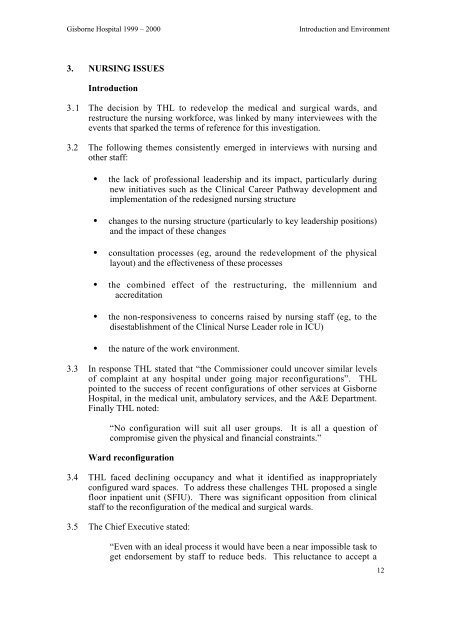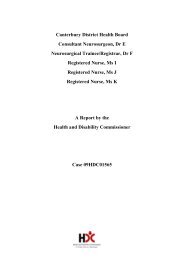Gisborne Hospital Report - Health and Disability Commissioner
Gisborne Hospital Report - Health and Disability Commissioner
Gisborne Hospital Report - Health and Disability Commissioner
You also want an ePaper? Increase the reach of your titles
YUMPU automatically turns print PDFs into web optimized ePapers that Google loves.
<strong>Gisborne</strong> <strong>Hospital</strong> 1999 – 2000<br />
Introduction <strong>and</strong> Environment<br />
3. NURSING ISSUES<br />
Introduction<br />
3.1 The decision by THL to redevelop the medical <strong>and</strong> surgical wards, <strong>and</strong><br />
restructure the nursing workforce, was linked by many interviewees with the<br />
events that sparked the terms of reference for this investigation.<br />
3.2 The following themes consistently emerged in interviews with nursing <strong>and</strong><br />
other staff:<br />
• the lack of professional leadership <strong>and</strong> its impact, particularly during<br />
new initiatives such as the Clinical Career Pathway development <strong>and</strong><br />
implementation of the redesigned nursing structure<br />
• changes to the nursing structure (particularly to key leadership positions)<br />
<strong>and</strong> the impact of these changes<br />
• consultation processes (eg, around the redevelopment of the physical<br />
layout) <strong>and</strong> the effectiveness of these processes<br />
• the combined effect of the restructuring, the millennium <strong>and</strong><br />
accreditation<br />
• the non-responsiveness to concerns raised by nursing staff (eg, to the<br />
disestablishment of the Clinical Nurse Leader role in ICU)<br />
• the nature of the work environment.<br />
3.3 In response THL stated that “the <strong>Commissioner</strong> could uncover similar levels<br />
of complaint at any hospital under going major reconfigurations”. THL<br />
pointed to the success of recent configurations of other services at <strong>Gisborne</strong><br />
<strong>Hospital</strong>, in the medical unit, ambulatory services, <strong>and</strong> the A&E Department.<br />
Finally THL noted:<br />
“No configuration will suit all user groups. It is all a question of<br />
compromise given the physical <strong>and</strong> financial constraints.”<br />
Ward reconfiguration<br />
3.4 THL faced declining occupancy <strong>and</strong> what it identified as inappropriately<br />
configured ward spaces. To address these challenges THL proposed a single<br />
floor inpatient unit (SFIU). There was significant opposition from clinical<br />
staff to the reconfiguration of the medical <strong>and</strong> surgical wards.<br />
3.5 The Chief Executive stated:<br />
“Even with an ideal process it would have been a near impossible task to<br />
get endorsement by staff to reduce beds. This reluctance to accept a<br />
12
















